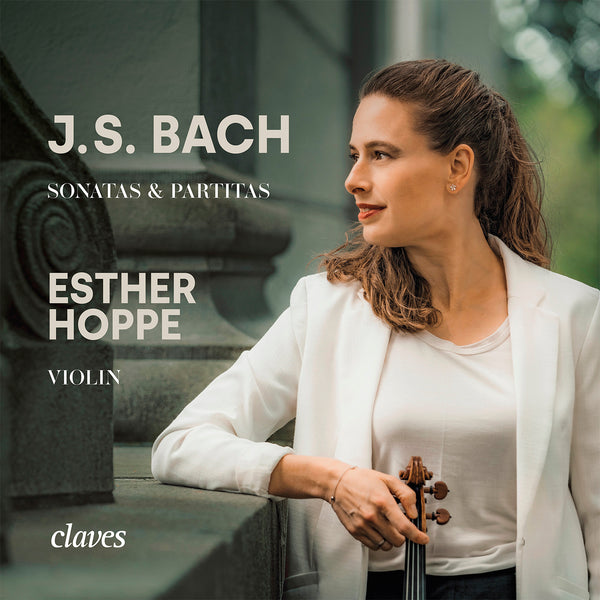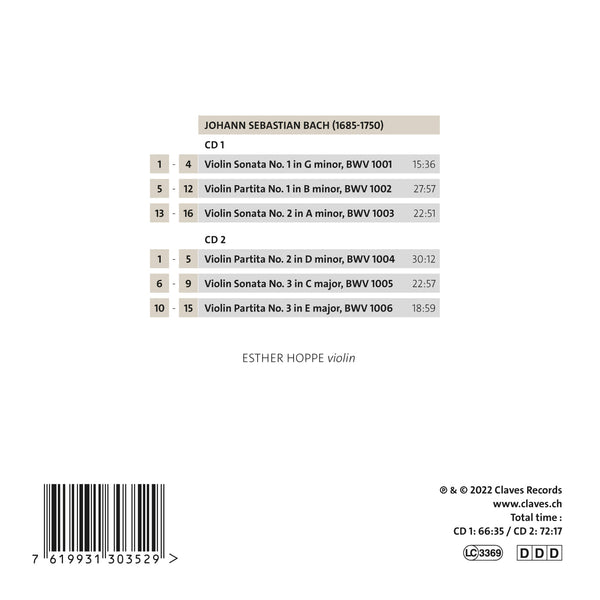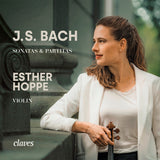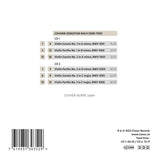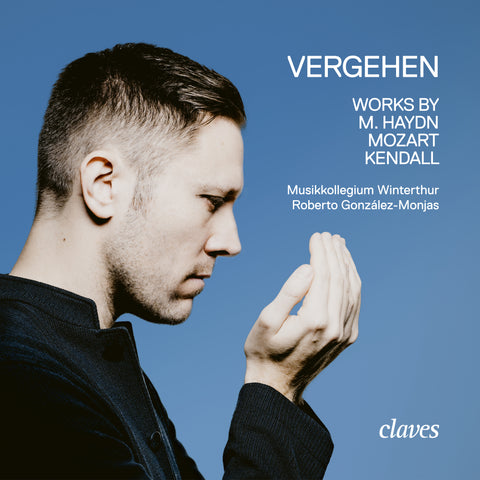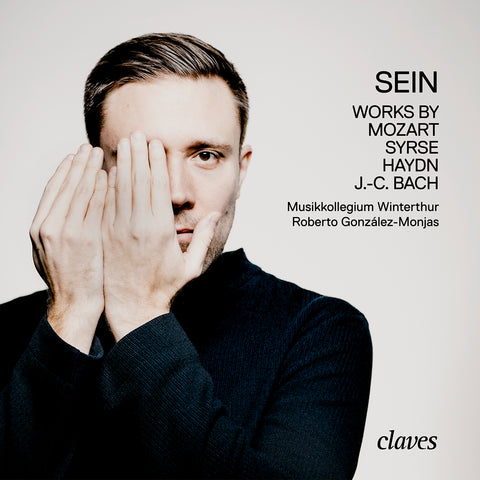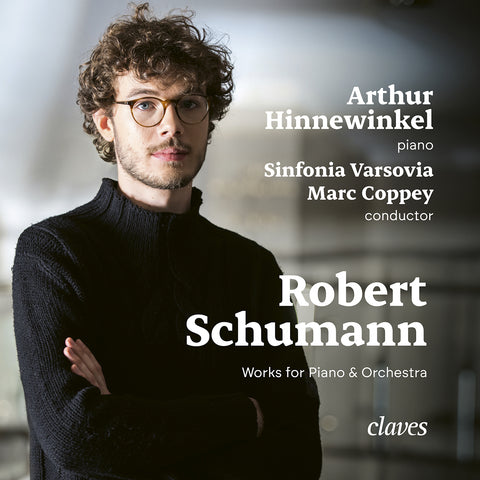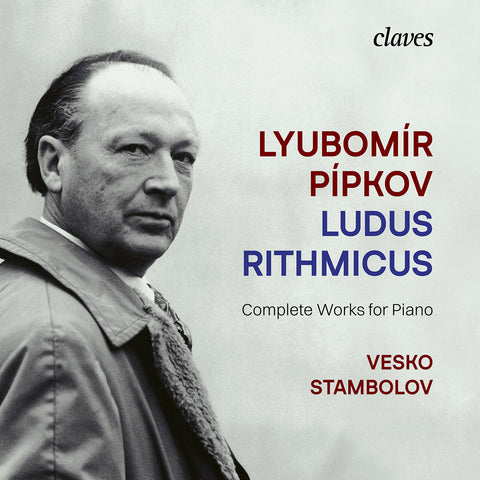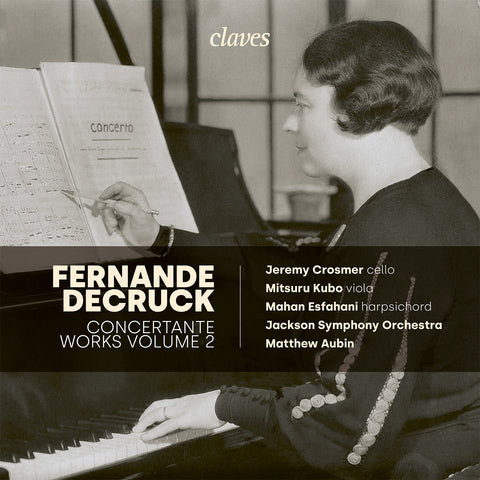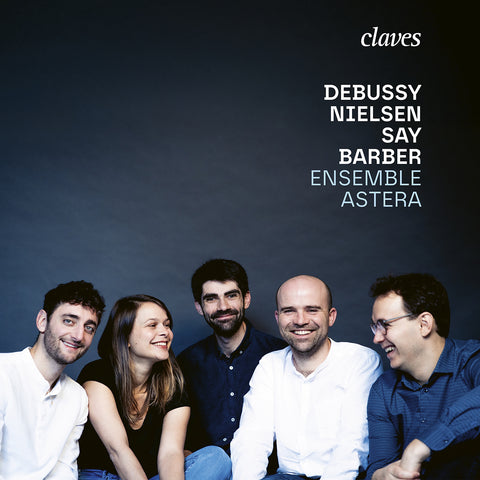(2022) J. S. Bach: Sonatas & Partitas for solo violin
Category(ies): Repertoire
Instrument(s): Violin
Main Composer: Johann Sebastian Bach
CD set: 2
Catalog N°:
CD 3035/36
Release: 30.09.2022
EAN/UPC: 7619931303529
This album is now on repressing. Pre-order it at a special price now.
CHF 24.00
This album is no longer available on CD.
This album has not been released yet. Pre-order it from now.
CHF 24.00
This album is no longer available on CD.
CHF 24.00
VAT included for Switzerland & UE
Free shipping
This album is no longer available on CD.
VAT included for Switzerland & UE
Free shipping
This album is now on repressing. Pre-order it at a special price now.
CHF 24.00
This album is no longer available on CD.
This album has not been released yet.
Pre-order it at a special price now.
CHF 24.00
This album is no longer available on CD.
CHF 24.00
This album is no longer available on CD.
J. S. BACH: SONATAS & PARTITAS FOR SOLO VIOLIN
Six Violin Sonatas and Partitas - BWV 1001 – 1006
The Violin Sonatas and Partitas manuscript, which has fortunately survived, is dated 1720. The first page of the autograph carries the note “Libro Primo”; Bach’s Cello Suites BWV 1007-1012 may have been regarded as the “Libro Secondo”. A dedicatee is not known. Johann Sebastian Bach composed his Violin Sonatas and Partitas when he was employed as Kapellmeister in Köthen (1717-1723) and probably completed the cycle in 1720.
There is hardly any other work in the entire violin literature with such significance. Bach set new standards in playing and composition; these works have lost none of their topicality and brilliance to this day.
Few composers had written works for unaccompanied violin before him, and indeed not entire cycles. However, it is assumed that Bach knew, for example, Johann Paul von Westhoff’s collection of Solo Violin Suites (1696). In his compositions, Westhoff had already attempted to create the illusion of bringing polyphonic music to life through an unaccompanied melodic instrument. Bach brought this art to an unsurpassable level of perfection in his Sonatas and Partitas.
The six Violin Sonatas and Partitas were already astonishingly widespread in the 18th century; many copies were produced. However, they only became widely known when the violinist Joseph Joachim, a close friend of Brahms, began to play them more frequently in the concert hall.
Today, it is impossible to imagine the violin repertoire without this cycle of works.
Esther Hoppe, violin
Swiss violinist Esther Hoppe has made a name for herself as a soloist, chamber musician and teacher at an international level.
After studying in Basel, Philadelphia, London and Zurich, she won 1st prize at the International Mozart Competition in Salzburg in 2002. As a member of the Tecchler Trio, she won numerous awards, including the German Music Competition, the Prix Crédit Suisse and 1st prize at the International ARD Competition in Munich.
In addition to appearances as a soloist (with the Bavarian Radio Symphony Orchestra, Royal Liverpool Philharmonic, Les Siècles, the Basel Chamber Orchestra and the Munich Chamber Orchestra, among others), she maintains an active career as a chamber musician. Her partners include Ronald Brautigam, Christian Poltéra, Francesco Piemontesi, Clemens and Veronika Hagen, Lars Anders Tomter, Heinz Holliger, Elisabeth Leonskaja and Pascal Moraguès.
She can be heard regularly at top-class festivals such as the Kammermusikfest Lockenhaus, Gstaad Menuhin Festival, Lucerne Festival, Edinburgh Festival, Musiktage Mondsee, Fjord Classics, Styriarte Graz, Delft Chamber Music Festival and Mozartwoche Salzburg.
Highly acclaimed CD recordings of works by composers such as Mozart, Stravinsky, Poulenc and Saint-Saëns have been released by Claves Records, Virgin Classics, Neos, Concentus Records and Ars Musici.
Esther Hoppe is professor for violin at the Mozarteum University in Salzburg.
She plays the “De Ahna” Stradivari violin from 1722 and a violin by Gioffredo Cappa from 1690.
Smart links (Album)
REVIEWS
« [..] Die international tätige Zuger Berufsviolinistin Esther Hoppe hat die sechs einzigartigen Bach-Werke auf CD eingespielt. Ende September ist diese am Markt erhältlich. Die Frage an die Zugerin, ob sie BWV 1001-1006 als eine Art Königsdisziplin der Geigenliteratur ansehen würde, bejaht sie. «Die Bach-Sonaten-und-Partiten werden von allen Geigerinnen und Geigern gleichermassen bewundert und gefürchtet, sie sind sozusagen unsere ständigen Begleiter», so Esther Hoppe. Die Kompositionen seien so gehaltvoll, dass man immer wieder Neues entdecke und Neues dazulerne. Viele würden die Werke täglich üben. Sie sind nicht zuletzt eine Art Massstab: «Denn sie zeigen gnadenlos auf, wenn an der musikalischen Interpretation oder an der Technik etwas fehlt», sagt die Musikerin. «Insofern kann man durchaus von sprechen.» Ideale Voraussetzungen für das ambitionierte Projekt Sie selbst war im frühen Teenageralter, als sie zum ersten Mal einen Satz aus diesem besonderen Zyklus eingeübt hat. [..] » - Andreas Faessler, September 2022
« [..] Elle incarne une forme de rigueur alliée à une profonde musicalité, avec des choix de tempo plutôt lents, quasi méditatifs. Elle prend soin de faire chanter et respirer son violon. Jusqu’à l’apothéose de la Chaconne, renversante. Puis elle a pu acquérir le Stradivarius nommé De Ahna, monté de manière moderne, qu’elle utilise dans le troisième numéro de cette ample partition, où l’instrument mélodique doit poser des accords et créer l’impression d’une polyphonie. La soliste suisse mesure toute la densité de ce chef-d’oeuvre insurpassé du violon solo. » - Elisabeth Hass, janvier 2023
« Die Einspielung der Solosonaten und -partiten von Bach ist ein Meilenstein im Leben jedes Geigers. Während der Pandemie fand die Schweizerin Esther Hoppe die Ruhe und Konzentration, ihre Version dieses Geigen-Kosmos für die CD festzuhalten. Das Besondere dabei: Hoppe spielt die Werke in Moll auf ihrer eigenen, dunkel klingenden Cappa-Violine, die beiden in Dur hingegen auf einer geliehenen Stradivari, was der sehr verinnerlichten, deutlich historischen Spielweisen verpflichteten Interpretation einen schön strahlenden Abschluss gibt.» - Reinmar Wagner, Februar 2023
« Sie sind die Krone der Violinmusik: Bachs Sonaten und Partiten, kein Geigerinnenleben ist komplett ohne sie. Diese Bedeutung ist auch in der Aufnahme der Schweizerin Esther Hoppe hörbar. Aber nicht nur. Die Geigerin verzichtet auf Schmelz zugunsten von Struktur, spielt elegant statt expressiv. Das Fundament ihres musikalischen Gebildes bilden die Basstöne, über denen sie leichtfüssige Gebilde zeichnet. Und in den weitgespannten Bögen, dem Formbewusstsein und den französisch zugespitzten Sechzehnteln scheinen die ursprünglichen Tänze auf, die den Sätzen zugrunde liegen. Einfach schön.» - Anna Kardos, Januar 2023
“[..] What these interpretations make clear in the first place is that Hoppe seems, as it were, to have grown attached to these six works: not only does she find it easy to play technically, but there is also a clear hint of a character of her own, prompted also by the interpretative space that the composer himself offers the interpreter in his music (which does not only apply to ornamentation). What may also have played a role in this is that in her role as a teacher she used the sonatas and partitas as teaching materials. From the flashy Presto from BWV 1002 and the richly colored voicing in the perfectly dosed Fugue from BWV 1003 to the deeply felt, glowing contemplation of the Ciaccona from BWV 1004: this is playing that continues to captivate from beginning to end. [..]” - Aart van der Wal, October 2022
« [..] La Zougoise Esther Hoppe, pour le label Claves, a le courage de prendre des risques, de défendre des propos qui pourraient même paraître contradictoires: jouer des oeuvres de 1720 sur des instrument de 1690 et 1722 et soutenir qu’«une approche historiquement informée ne doit pas nuire à la grandeur atemporelle de cette musique». En l’écoutant, on a l’impression de comprendre. Esther Hoppe semble aller puiser dans son for intérieur, mettre en scène ces oeuvres dans les parois de son théâtre intime, à la recherche de ce qui vibre au plus profond d’elle-même. Elle joue ainsi précisément le jeu de Bach, son exercice spirituel et méditatif, sans contrainte. On est frappé·e par cette voix intime qui s’élève, articule sa propre poésie dans le flot délicat d’une élocution mélancolique, d’idées mélodiques qui sortent timidement de l’ombre de la pensée vers la lumière du soleil, ou dans le tourbillon si superbement égrené des mouvements plus rapides. [..] » - Gianluigi Bocelli, septembre 2022
« Sie hat es gewagt. Viele Jahre lang habe sie sich mit den Sonaten und Partiten für Violine solo von Johann Sebastian Bach beschäftigt, jetzt sei die Zeit gekommen, sagt Esther Hoppe. So hat die Schweizer Geigerin, die seit zehn Jahren eine Professur am Mozarteum Salzburg versieht und auf Beginn der Saison 2024/25 die Leitung der Camerata Zürich übernimmt, ihre Instrumente geschultert und ist ins Aufnahmestudio gegangen. [..] In gelöster Einlässlichkeit horcht Esther Hoppe in die Musik Bachs hinein; sie lässt sie gleichsam aus sich selbst heraus entstehen und schafft ihr damit den Raum, in dem sie sich dem Zuhörer, der Zuhörerin in ihrer ganzen Schönheit, auch dem ganzen Raffinement ihrer Erfindung zeigt. [..] » - Peter Hagmann, April 2023
(2022) J. S. Bach: Sonatas & Partitas for solo violin - CD 3035/36
Six Violin Sonatas and Partitas - BWV 1001 – 1006
The Violin Sonatas and Partitas manuscript, which has fortunately survived, is dated 1720. The first page of the autograph carries the note “Libro Primo”; Bach’s Cello Suites BWV 1007-1012 may have been regarded as the “Libro Secondo”. A dedicatee is not known. Johann Sebastian Bach composed his Violin Sonatas and Partitas when he was employed as Kapellmeister in Köthen (1717-1723) and probably completed the cycle in 1720.
There is hardly any other work in the entire violin literature with such significance. Bach set new standards in playing and composition; these works have lost none of their topicality and brilliance to this day.
Few composers had written works for unaccompanied violin before him, and indeed not entire cycles. However, it is assumed that Bach knew, for example, Johann Paul von Westhoff’s collection of Solo Violin Suites (1696). In his compositions, Westhoff had already attempted to create the illusion of bringing polyphonic music to life through an unaccompanied melodic instrument. Bach brought this art to an unsurpassable level of perfection in his Sonatas and Partitas.
The six Violin Sonatas and Partitas were already astonishingly widespread in the 18th century; many copies were produced. However, they only became widely known when the violinist Joseph Joachim, a close friend of Brahms, began to play them more frequently in the concert hall.
Today, it is impossible to imagine the violin repertoire without this cycle of works.
Esther Hoppe, violin
Swiss violinist Esther Hoppe has made a name for herself as a soloist, chamber musician and teacher at an international level.
After studying in Basel, Philadelphia, London and Zurich, she won 1st prize at the International Mozart Competition in Salzburg in 2002. As a member of the Tecchler Trio, she won numerous awards, including the German Music Competition, the Prix Crédit Suisse and 1st prize at the International ARD Competition in Munich.
In addition to appearances as a soloist (with the Bavarian Radio Symphony Orchestra, Royal Liverpool Philharmonic, Les Siècles, the Basel Chamber Orchestra and the Munich Chamber Orchestra, among others), she maintains an active career as a chamber musician. Her partners include Ronald Brautigam, Christian Poltéra, Francesco Piemontesi, Clemens and Veronika Hagen, Lars Anders Tomter, Heinz Holliger, Elisabeth Leonskaja and Pascal Moraguès.
She can be heard regularly at top-class festivals such as the Kammermusikfest Lockenhaus, Gstaad Menuhin Festival, Lucerne Festival, Edinburgh Festival, Musiktage Mondsee, Fjord Classics, Styriarte Graz, Delft Chamber Music Festival and Mozartwoche Salzburg.
Highly acclaimed CD recordings of works by composers such as Mozart, Stravinsky, Poulenc and Saint-Saëns have been released by Claves Records, Virgin Classics, Neos, Concentus Records and Ars Musici.
Esther Hoppe is professor for violin at the Mozarteum University in Salzburg.
She plays the “De Ahna” Stradivari violin from 1722 and a violin by Gioffredo Cappa from 1690.
Smart links (Album)
REVIEWS
« [..] Die international tätige Zuger Berufsviolinistin Esther Hoppe hat die sechs einzigartigen Bach-Werke auf CD eingespielt. Ende September ist diese am Markt erhältlich. Die Frage an die Zugerin, ob sie BWV 1001-1006 als eine Art Königsdisziplin der Geigenliteratur ansehen würde, bejaht sie. «Die Bach-Sonaten-und-Partiten werden von allen Geigerinnen und Geigern gleichermassen bewundert und gefürchtet, sie sind sozusagen unsere ständigen Begleiter», so Esther Hoppe. Die Kompositionen seien so gehaltvoll, dass man immer wieder Neues entdecke und Neues dazulerne. Viele würden die Werke täglich üben. Sie sind nicht zuletzt eine Art Massstab: «Denn sie zeigen gnadenlos auf, wenn an der musikalischen Interpretation oder an der Technik etwas fehlt», sagt die Musikerin. «Insofern kann man durchaus von sprechen.» Ideale Voraussetzungen für das ambitionierte Projekt Sie selbst war im frühen Teenageralter, als sie zum ersten Mal einen Satz aus diesem besonderen Zyklus eingeübt hat. [..] » - Andreas Faessler, September 2022
« [..] Elle incarne une forme de rigueur alliée à une profonde musicalité, avec des choix de tempo plutôt lents, quasi méditatifs. Elle prend soin de faire chanter et respirer son violon. Jusqu’à l’apothéose de la Chaconne, renversante. Puis elle a pu acquérir le Stradivarius nommé De Ahna, monté de manière moderne, qu’elle utilise dans le troisième numéro de cette ample partition, où l’instrument mélodique doit poser des accords et créer l’impression d’une polyphonie. La soliste suisse mesure toute la densité de ce chef-d’oeuvre insurpassé du violon solo. » - Elisabeth Hass, janvier 2023
« Die Einspielung der Solosonaten und -partiten von Bach ist ein Meilenstein im Leben jedes Geigers. Während der Pandemie fand die Schweizerin Esther Hoppe die Ruhe und Konzentration, ihre Version dieses Geigen-Kosmos für die CD festzuhalten. Das Besondere dabei: Hoppe spielt die Werke in Moll auf ihrer eigenen, dunkel klingenden Cappa-Violine, die beiden in Dur hingegen auf einer geliehenen Stradivari, was der sehr verinnerlichten, deutlich historischen Spielweisen verpflichteten Interpretation einen schön strahlenden Abschluss gibt.» - Reinmar Wagner, Februar 2023
« Sie sind die Krone der Violinmusik: Bachs Sonaten und Partiten, kein Geigerinnenleben ist komplett ohne sie. Diese Bedeutung ist auch in der Aufnahme der Schweizerin Esther Hoppe hörbar. Aber nicht nur. Die Geigerin verzichtet auf Schmelz zugunsten von Struktur, spielt elegant statt expressiv. Das Fundament ihres musikalischen Gebildes bilden die Basstöne, über denen sie leichtfüssige Gebilde zeichnet. Und in den weitgespannten Bögen, dem Formbewusstsein und den französisch zugespitzten Sechzehnteln scheinen die ursprünglichen Tänze auf, die den Sätzen zugrunde liegen. Einfach schön.» - Anna Kardos, Januar 2023
“[..] What these interpretations make clear in the first place is that Hoppe seems, as it were, to have grown attached to these six works: not only does she find it easy to play technically, but there is also a clear hint of a character of her own, prompted also by the interpretative space that the composer himself offers the interpreter in his music (which does not only apply to ornamentation). What may also have played a role in this is that in her role as a teacher she used the sonatas and partitas as teaching materials. From the flashy Presto from BWV 1002 and the richly colored voicing in the perfectly dosed Fugue from BWV 1003 to the deeply felt, glowing contemplation of the Ciaccona from BWV 1004: this is playing that continues to captivate from beginning to end. [..]” - Aart van der Wal, October 2022
« [..] La Zougoise Esther Hoppe, pour le label Claves, a le courage de prendre des risques, de défendre des propos qui pourraient même paraître contradictoires: jouer des oeuvres de 1720 sur des instrument de 1690 et 1722 et soutenir qu’«une approche historiquement informée ne doit pas nuire à la grandeur atemporelle de cette musique». En l’écoutant, on a l’impression de comprendre. Esther Hoppe semble aller puiser dans son for intérieur, mettre en scène ces oeuvres dans les parois de son théâtre intime, à la recherche de ce qui vibre au plus profond d’elle-même. Elle joue ainsi précisément le jeu de Bach, son exercice spirituel et méditatif, sans contrainte. On est frappé·e par cette voix intime qui s’élève, articule sa propre poésie dans le flot délicat d’une élocution mélancolique, d’idées mélodiques qui sortent timidement de l’ombre de la pensée vers la lumière du soleil, ou dans le tourbillon si superbement égrené des mouvements plus rapides. [..] » - Gianluigi Bocelli, septembre 2022
« Sie hat es gewagt. Viele Jahre lang habe sie sich mit den Sonaten und Partiten für Violine solo von Johann Sebastian Bach beschäftigt, jetzt sei die Zeit gekommen, sagt Esther Hoppe. So hat die Schweizer Geigerin, die seit zehn Jahren eine Professur am Mozarteum Salzburg versieht und auf Beginn der Saison 2024/25 die Leitung der Camerata Zürich übernimmt, ihre Instrumente geschultert und ist ins Aufnahmestudio gegangen. [..] In gelöster Einlässlichkeit horcht Esther Hoppe in die Musik Bachs hinein; sie lässt sie gleichsam aus sich selbst heraus entstehen und schafft ihr damit den Raum, in dem sie sich dem Zuhörer, der Zuhörerin in ihrer ganzen Schönheit, auch dem ganzen Raffinement ihrer Erfindung zeigt. [..] » - Peter Hagmann, April 2023
Return to the album | Read the booklet | Composer(s): Johann Sebastian Bach | Main Artist: Esther Hoppe






